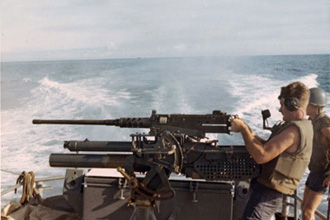 |
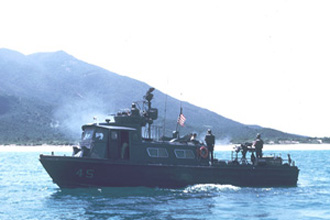 |
| Rules of Engagement |
| Ca Na - Song Tra Bong |
|
| Music by Gordon Lightfoot� | "Gunfight at Co Lay Corral" "The other folks ALWAYS fired first" |
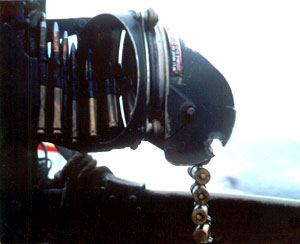 PCF-99 gun tub hostile bullet entry |
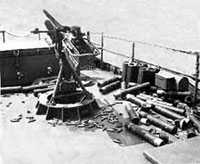 PCF-99 fantail after "Gunfight" |
During 1967 the Swift Boats, like many American units in country at the time, operated under a fairly restrictive set of Rules of Engagement that constrained where they could go and under what conditions they could engage in contact with enemy forces. The essence of these rules can be summarized in the following paraphrasing: |
|
Direct fire against any suspected enemy activity was prohibited unless the U.S. vessel had first received incoming fire from the suspected activity.
Indirect fire in support of land units required that the firing vessel obtain previous authorization from the appropriate Corps Command structure. Since this authorization involved co-ordination between the US Navy and the US Army commands, this usually took several hours. By that time, the need for indirect fire support had long since past.
Swift Boats were specifically restricted from operating inside the rivers in areas beyond just the immediate sea entrance. |
Transgressions of these rules, which would have been considered part of normal operating procedures only a year or so later, and perhaps even praised, were looked on as very serious administrative matters during 1967 when brought to the attention of "higher authority" Needless to say, Rule #1 placed us at a severe disadvantage when it came to the possibility of punctures to the more tender parts of our bodies. This was especially true with Psychological Warfare "Chieu Hoi" operations involving the boat slowly cruising close in to suspected enemy land areas and blasting appeals over a loudspeaker for surrender. |
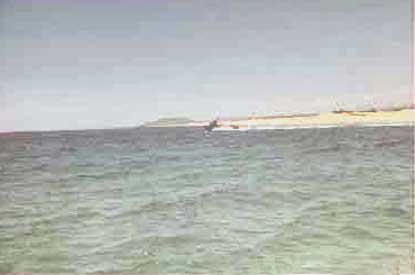 |
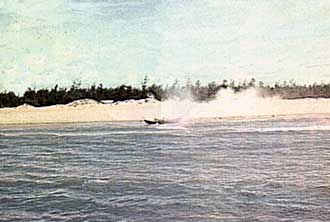 |
But being young and enthusiastic, such operations were modified to take full advantage of the rule. This involved a formation of two boats. The "bait" proceeded just off the shore line, hoping to provoke hostile action, while a second boat followed further out ready to come to the aid of the first if the provocation was successful. {One specific reason that short range tactical radios were important.} When conducted at night, the maneuver was made at a moderate pace. During daylight the pace of the inshore boat was increased appropriately. The inshore boat in this image was moving briskly along the surf line of a sandy beach north of Chu Lai in an area where Viet Cong activity had been reported. The outboard boat was able to quickly move in and provide support as hostile actions were received from the shore and suspious sanpams. For more aggressive crews, this maneuver would be conducted by the single boat in a particular area. Such tactics were only sometimes successful, but they produced enough results that they became an unauthorized "macho sport" of the boats in the Chu Lai area. |
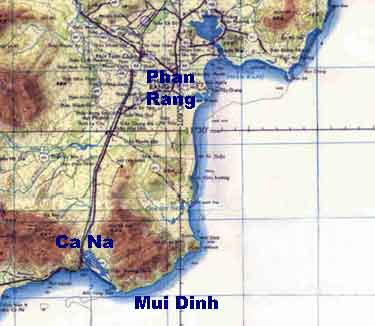 |
Violations of Rules #2 and #3 held out an excellent possibility of some really unpleasant administrative action. However, Swift Boat crews exhibiting even the slightest amount of aggressiveness were very likely to run afoul of these rules sometime during their tour. Fortunately, our division COs were very sympathetic to our plight on those occasions, and really went to bat for us. The following minor incidents, neither involving actual combat, were indicative of the ways this could come about. The first occurred very early in the tour of the Sand Pebble #45 crew. We were on assigned patrol in one of the southern most areas of Coastal Division 14's responsibility. |
To arrive in the patrol area, you passed south of Phan Rang and "rounded Mui Dinh," a prominent point of land in that part of the country. The area of responsibility was to cover the coastline just off of the small town of Ca Na. It would be unfair to say that Ca Na was a backwater of the war. However, being in a coastal zone located in the central region of the country, it was relatively quiet with little American military presence in the area. |
The town itself was protected by a contingent of South Vietnamese Regional and Popular Forces (nicknamed Ruff Puffs) with an American military advisor. In this capacity, the advisor had a tough job scraping together needed support resources for his irregular troops. So when he requested PCF 45 to provide "on call" illumination support against a limited probe on his compound by a small cadre of local VC, which his intelligence sources indicated was very probable during the night, we were willing to oblige. Illumination "surely" was exempt from Rule #2 | 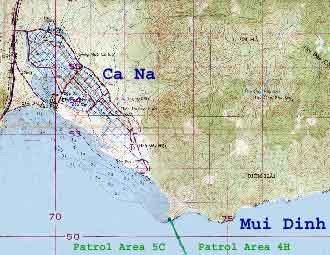 |
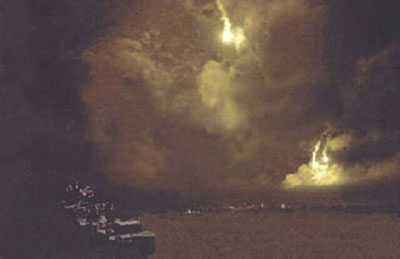 |
When the call came, we accomplished what we considered a credible job of repeatedly keeping three illumination flares going continuously over the Ruff Puff compound for the better part of an hour. We kept in constant communications with the advisor, who informed us that our efforts in turning darkness into daylight assisted greatly in the probe being quickly dispersed with only a few incoming rounds taken. We were confident that we had performed our job well, were able to help out some allies in need, and never fired a shot in anger. |
|
However, this confidence took a nose dive upon our return to Cam Ranh Bay. Our division commander urgently greeted the crew upon docking with a message from the II Corps Command Headquarters. |
The advisor had sent in a report of the incident, praised the good support he had received from the Navy, and included a note crediting our boat with the destruction of a small wooden bridge next to his compound. The II Corps Commander wanted to know what disciplinary action was going to be taken against the unit cited for violation of Rule #2 !! Evidently the timed fuse on one of the illumination rounds had suffered a malfunction, with the flare going off on the bridge instead of high overhead. It took some explaining, and an inventory of our ammo load, but we finally convinced the division commander that our support of Ca Na was benign, and he covered our rear ends with the Army higher ups. We later asked the advisor to be more discrete about what he put in his official reports. |
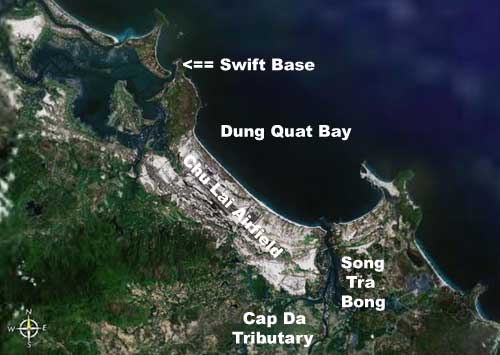 |
The other minor incident where PCF 45 attained "command visibility", this time with Rule #3, occurred while patrolling Dung Quat Bay just off the US Base and Airfield at Chu Lai. This was a particularly boring assignment in that the entire area was a "No Junk" zone. Non-military vessels were restricted from operating in the bay, and it would have taken a really foolish VC unit to have attempted any activity from the sea there. The VC were "cagey," but not foolish. It was most likely the tedium of the assignment that led to our transgression. The company CO of an Americal unit at a perimeter defense location on the banks of a tributary of the Song Tra Bong river, at the southern end of the bay, contacted us and wanted to know if we could add the fire power of our .50 caliber MGs to his own smaller caliber weapons against attacks he had been receiving from the opposite river bank. He expected another such action that evening. We knew that permission to provide such support would have been turned down flatly. But a quick poll of the crew (Swift Boats were more democratic than most military units) on whether or not we should provide the requested support anyway, resulted in a unanimous "Hell Yes !"
|
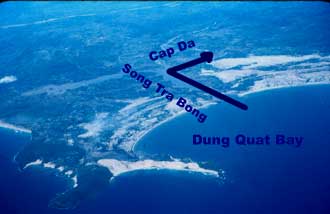 |
 |
Photograph courtesy of Bob Bolger |
In the event, the operation turned out to be a bust. Our mere presence may have been a deterence. Or the Viet Cong may have just decided to take the night off. At any rate, the expected action simply didn't materialize. So we departed, leaving at least this one army unit happy that Navy resources were available to protect their river side flank. Unfortunately, on our way out of the Song Cap Da, we scraped a rock with our port screw. This produced a noticeable vibration in the port shaft which simply could not be ignored. We were forced to fess up to our little escapade and take the inevitable consequences. Running aground was a very big "no no" in the traditional Navy. And having it happen in a forbidden place just added to the possibility of administrative repercussions. This time the explanations were very long and extensive. Fortunately, our leader at Coastal Division 16 was pretty aggressive in his own right. He chalked up the damage as being part of "normal patrol operations" and his attention and reports forwarded upward concentrated on the possible ways to repair the problems with the port shaft. The leaders in Da Nang and Cam Ranh did not necessarily take a similar view, and PCF 45 was lucky to escape with only a strong admonition that such activities would not be countenanced. The silver bullet was ducked ... but just barely. |
| "Only 154 more days and a wake up"> |
All's well that ends well, however. We were "required" to spend a couple of days "R & R" off patrol at Qui Nhon, where the facilities were available to lift the boat out of the water and correct the port shaft and screw vibrations. The lessons learned from the above incidents were that aggressiveness needed to be tempered with steps to maintain a low profile concerning the shore based command structure. At the very least, the boat absolutely must report that the other side had fired shots first if a decision or particular action was likely to be reviewed by an arm chair warrior. And that was the approach that most Swift Boat crews used for operations in the days of 1967. |
Actually, running aground in a Swift Boat became a not-so-unsual occurance later in the war. "Post Tet," the
Swifts were moved to augment the interdiction of infltration attempts along the rivers, klongs and canals of the lower
Mekong near Cambodia. Several of the boats got caught at low tide in the rivers or missed turns in the waterways at night
and ended up in rice fields.
The dilemas of PCF59 and PCF98 put poor old Sand Pebble #45's minor encounter with a rock to shame! Note the furrows dug by the 98 boat's twin screws as she tried to help the farmer plow his field!! The Navy did come to its senses that some of the traditional "deep water" thinking needed to be revised in order to be successful in
the quite different enviornment of this shore and river "brown water" conflict. Perhaps the experiences in 1967 helped
with this change in attitude.
|
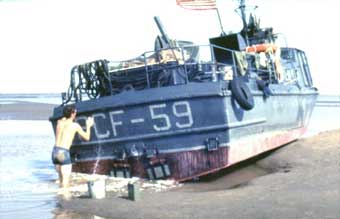 |
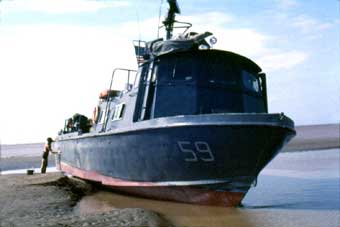 |
|
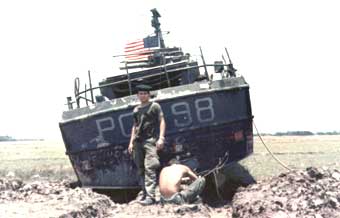 |
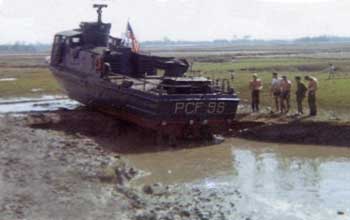 |
And lifting boats out of the water to make repairs to the screws/shafts/struts also became almost routine. These skills became quite useful to some Swift Boat sailors in 1999 when the Coronado training Swift, PCF-104, was discovered in the Navy yard in Bangor, Washington. This boat was lifted by crane onto a flat bed and transported to the Naval Amphibious Base at Coronado where it was restored to pristine condition |
 |
 |
| The boat is now part of the Vietnam Unit Memorial dedicated to all the sailors that served in the "Brown Water Navy" Including Swifts, Patrol Boats River and the Riverine Force Craft. |
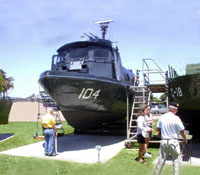 |
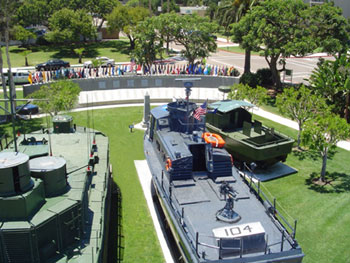 |
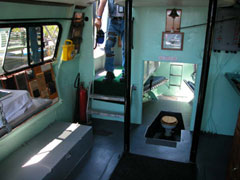 |
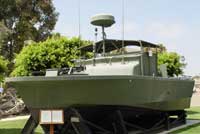 |
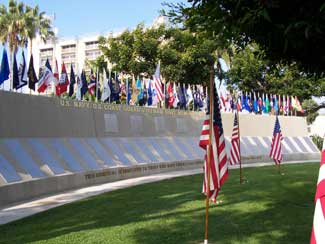 |
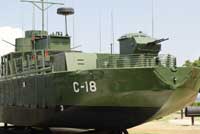 |
| Neil Geis (former CosRon One staff officer at Cam Ranh), Bob Bolger (OinC PCF-99 Chu Lai) and John Branca (Engineman at Qui Nhon and Da Nang) are shown adding needed brasso touches to the twin screws on PCF-104. John (right) has since departed on his last patrol |
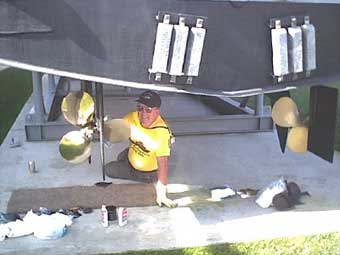 |
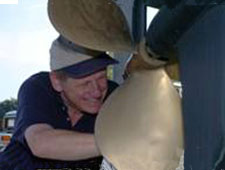 |
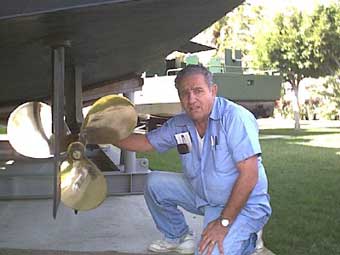 |
This web site is Copyright � 2002 by Robert B. Shirley. All rights reserved. Click on image to return to the homepage
|